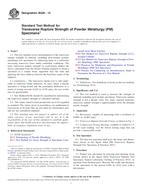We need your consent to use the individual data so that you can see information about your interests, among other things. Click "OK" to give your consent.
ASTM B528-12
Standard Test Method for Transverse Rupture Strength of Powder Metallurgy (PM) Specimens
STANDARD published on 1.11.2012
The information about the standard:
Designation standards: ASTM B528-12
Note: WITHDRAWN
Publication date standards: 1.11.2012
SKU: NS-7041
The number of pages: 3
Approximate weight : 9 g (0.02 lbs)
Country: American technical standard
Category: Technical standards ASTM
The category - similar standards:
Annotation of standard text ASTM B528-12 :
Keywords:
flexural strength, 3 Point Bend Test, transverse rupture, transverse rupture strength, TRS, ICS Number Code 77.160 (Powder metallurgy)
Additional information
| Significance and Use | ||||||||||
|
4.1 This test method is used to measure the strength of sintered, including post-treated, specimens. Transverse rupture strength is not a design value. For many sintered materials, transverse rupture strength is approximately twice the ultimate tensile strength. |
||||||||||
| 1. Scope | ||||||||||
|
1.1 This test method covers determination of the transverse rupture strength of sintered, including post-treated, powder metallurgy test specimens by subjecting them to a uniformly increasing transverse force under controlled conditions. The term “transverse rupture strength” as used herein, defines the stress, calculated from the flexure formula required to break a specimen as a simple beam supported near the ends and applying the force midway between the fixed line center of the supports. 1.2 Limitations—The transverse rupture test is only applicable to relatively brittle materials. In cases where a ductile specimen is being tested and the permanent deflection as a result of testing exceeds 0.020 in. (0.50 mm), the test results may be questionable. 1.3 Test Method B406 should be consulted for determining the transverse rupture strength of cemented carbides. 1.4 The values stated in inch-pound units are to be regarded as standard. The values given in parentheses are mathematical conversions to SI units that are provided for information only and are not considered standard. 1.5 This standard does not purport to address all of the safety concerns, if any, associated with its use. It is the responsibility of the user of this standard to establish appropriate safety and health practices and determine the applicability of regulatory limitations prior to use. |
||||||||||
| 2. Referenced Documents | ||||||||||
|



 Cookies
Cookies
